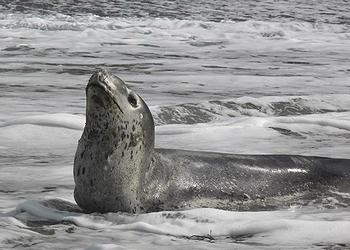
AUCKLAND, New Zealand, May 31, 2019 (ENS) – New Zealand’s newest residents like being alone, have leopard-like spots, and can each weigh up to 600 kilos (1,320 pounds). This week leopard seals have gone from being officially classified as vagrants, to recognition as residents of New Zealand.
The New Zealand Department of Conservation announced its latest Marine Mammal Threat Classification System Report on Monday, reclassifying leopard seals as New Zealand residents.

This is a huge step forward for the leopard seal, Hydrurga leptonyx, says cetacean biologist Dr. Krista Hupman with New Zealand’s National Institute of Water and Atmospheric Research, NIWA, who is delighted with the change to leopard seal status.
Dr. Hupman attributes this success to a female leopard seal named Owha, who made the Waitemata Harbour her territory in 2012.
For the past seven years, Owha has been moving between Dunedin, the Bay of Plenty, Auckland and Whangarei sleeping on pontoons and wallowing in the shallows. She prompted Dr. Hupman to research the prevalence and residency of leopard seals in New Zealand to find out if they were truly vagrant visitors to New Zealand shores.
“This is a positive outcome for Owha and other leopard seals in New Zealand. For Owha, she can safely spend her days sunning on the marina pontoons. For New Zealanders, we are extremely fortunate to have what was previously known as an Antarctic species as a resident member of our unique biodiversity,” Hupman said.
Leopard seals are known as an Antarctic species, widely distributed throughout the Antarctic pack ice and second only to killer whales in the list of Antarctica’s top predators.
Leopard seals prey on a variety of species: krill, penguins, birds, fish, seals and cephalopods, whatever is readily available.
They are the only seals known to regularly hunt and kill warm-blooded prey, including other seals. Although rare, there are a few records of adult leopard seals attacking humans. There has also been one fatality when a researcher was snorkeling in Antarctic waters and was killed by a leopard seal.
Leopard seals have never been systematically exploited. Currently, they are protected under the Convention for the Conservation for Antarctic Seals (1972) limiting kill to 12,000 in any one year. Other threats include the entanglement in marine debris and harassment by the public and by dogs.
The IUCN Red List of Threatened Species classifies the leopard seal as a species of Least Concern.
“New Zealand was thought to be well out of their normal range yet their numbers have been increasing here, and animals like Owha have been staying here for a number of years,” Hupman said.
Together with fellow researcher Dr. Ingrid Visser, Hupman set up LeopardSeals.org, a nonprofit organization established to foster more understanding about leopard seals.
Dr. Hupman also set up a 0800 LEOPARD hotline for the public to report sightings of leopard seals. The information enabled the identification of 216 individual leopard seals that had visited New Zealand shores, including 74 individuals in 2018 alone.
Hupman and the LeopardSeals.org team scoured historical records from newspapers and museums and compiled more than 3,000 sighting records, including some from Māori middens, showing leopard seals had been part of the New Zealand’s native fauna for centuries.
“Such an extensive database enabled us to show that not only were leopard seals living next to our cities, but they could be found all year round and in predictable locations,” Hupman said.
She found that some leopard seals had remained in New Zealand year after year and that three births have been documented on the New Zealand mainland.
Leopard seals also had a moment in the spotlight in February when Dr. Hupman’s team at NIWA discovered a USB stick in a leopard seal droppings or scat. The scats are collected so researchers can learn more about what the seals eat and their overall health – all part of learning more about why these animals may be visiting New Zealand in larger numbers.
To report a leopard seal sighting: Call 0800 LEOPARD (0800 5367273). Record the date, time and location and if possible, take a photograph. As leopard seals are wild animals, the Department of Conservation recommends staying at least 20 meters (60 feet) away from them.
“It just shows what New Zealanders working together can achieve,” said Hupman, who attributes the success of the status change to the dedicated citizen scientists and researchers around New Zealand who reported sightings and volunteered their time to assist with this work.
“Our next challenge is to understand their role in our ecosystem and to educate people about this magnificent addition to our whanau,” said Dr. Hupman, who views leopard seals as part of New Zealand’s extended family.
It is an offense under the Marine Mammal Act 1979 (MMPA) to disturb, harass, harm, injure or kill a seal. A dog owner whose dog attacks a seal could face prosecution.
Anyone charged under the MMPA with harassing, disturbing, injuring or killing a seal faces a maximum penalty of two years imprisonment or a fine up to a maximum of $250,000.
Copyright Environment News Service (ENS) 2019. All rights reserved.
